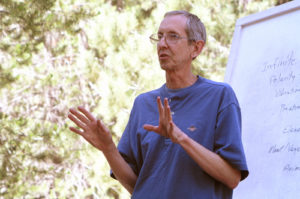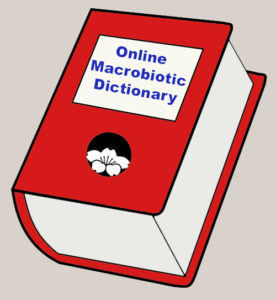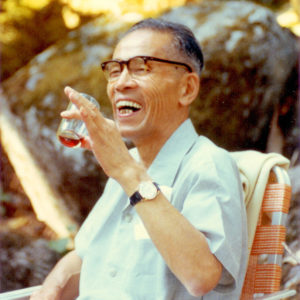
Completed Entries
Large, flat white or whole wheat noodles, often served in soup.
Japanese plum. A sour green fruit that looks like an unripened apricot.
Strong concentrate made from Japanese plums (ume) without adding salt. It is very alkalizing when eaten, usually in very small amounts.
Pink liquid that results from fermenting Japanese plums (ume). Ume zu has a sour taste can can be substituted for vinegar and/or salt in any recipe.
Japanese plums pickled with salt and beefsteak leaves (shiso), used for seasoning and for therapeutic reasons, it is very salty. It is available as the whole plum, plum paste, or plum extract.
See Cautionary note.
Ground umeboshi (including pits) and white flour made into a paste-like consistency and used for eye infections or arthritis.
See Cautionary note.
Ground umeboshi kernels, saké, and white flour made into a paste-like consistency and used for bone marrow disease.
See Cautionary note.
Cold water, ume extract, and salt used as a compress for non-poisonous snakebites.
See Cautionary note.
Hot water and ume extract used as a gargle to kill throat bacteria.
See Cautionary note.
Umeboshi (salt plum) boiled in bancha tea with a little soy sauce (shoyu) added.
Eel.
The unifying principle of yin and yang is a set of theorems used as tools to make daily decisions and shows that all apparent opposites are complementary; that is, connected. One can focus on either side of any pair or on the unification of them. The Unifying Principle is also called “the law of change” that governs all phenomena, visible and invisible. Evidence of this law is seen as opposites turn into each other; for examples, night becoming day, sickness becoming health, ignorance becoming wisdom, and so on—and all vice versa. The twelve theorems are:
- “Yin and Yang are two poles which enter into play when the infinite expansion manifests itself at the point of bifurcation (divided into two branches).” This is the beginning of the finite world as Infinity (nonduality) becomes two (duality). In other words, for anything to exist, its opposite must also exist.
- “Yin and Yang are produced continually by the transcendental expansion.” The finite world is dependent on Infinity (Oneness) for its continuous existence. Without the fundamental forces of opposition (yin and yang), nothing, including life, would be possible.
- “Yin is centrifugal. Yang is centripetal. Yin and Yang produce energy.” Yin activity is the outward, centrifugal force and produces expansion, lightness, cold, and so on. Yang activity is the inward, centrifugal force and produces contraction, heaviness, heat, and so on.
- “Yin attracts Yang. Yang attracts Yin.” Everything is attracted to its opposite. Someone who is more yin will be attracted to people and things that are more yang, and vice versa.
- “Yin and Yang combined in variable proportion produce all phenomena.” An infinite variety of combinations and proportions of yin and yang produces energy and all other things, both visible and invisible.
- “All phenomena are ephemeral, being of infinitely complex constitutions and constantly changing Yin and Yang components. Everything is without rest.” Everything is constantly changing its yin and yang characteristics—everything is restless. What is more yin one day can become more yang the next, and vice versa.
- “Nothing is totally Yin or totally Yang, even in the most apparently simple phenomenon. Everything contains a polarity at every stage of its composition.” Everything in this finite world is composed of both yin characteristics and yang characteristics. There is nothing that is all yin or all yang. In other words, yin and yang are not absolute qualities; they are relative qualities.
- “Nothing is neutral. Yin or Yang is in excess in every case.” If the yin characteristics dominate, then the thing is called “more yin.” If the yang characteristics dominate, then the thing is called “more yang.”
- “The force of attraction is proportional to the difference of the Yin and Yang components.” Two things that are far apart in terms of yin and yang force will have a much greater affinity than two things that are closer together in terms of yin and yang force.
- “Yin repels Yin and Yang repels Yang. The repulsion is inversely proportional to the difference of the Yin and Yang forces.” The more alike two things are in terms of yin and yang force, the more they will repel each other. The farther apart they are, the weaker the repulsion.
- “With time and space, Yin produces Yang, and Yang produces Yin.” At the extremity of development, something that is moving in the yin direction will begin moving in the yang direction, and vice versa. At some point in the depth of winter (more yin), the seasons begin to move toward summer (more yang).
- “Every physical body is Yang at its center and Yin toward the surface.” The surface (periphery) of everything is more yin and the center of the same thing is more yang, because yin is the representation of the outward force and yang is the representation of the inward force.
Herman Aihara’s idea that the infinite universe is like a television company broadcasting all thoughts, memory, and imagination—the ones we pick up depend on the quality of our individual set (body and mind). The more clear and calm we become, the greater and more advanced our thinking becomes because we pick up higher quality thoughts.
Another name for the Seven Laws of the Order of the Universe.
See Seven Laws of the Order of the Universe.
The Infinite Universal Self is always materializing into the center (the small self) and then unwinding back to infinity. The long way is along the spiral. Prayer and fasting is the shortcut to the Infinite—contemplation on the Order of the Universe and eating and drinking only what is necessary.
Goals produced by a Senate Select Committee headed by George McGovern in 1977 that affirmed that Americans need to consume more grains and vegetables and less meat and sugar.
Projected Entries
Ueshiba
Ulcerative disease
Ulcers
Ume-sho-kuzu drink
Umeboshi vinegar
Ume-sho-bancha
Ume-sho-kuzu
Unrefined oil
Uterine bleeding
Questions or Comments?




